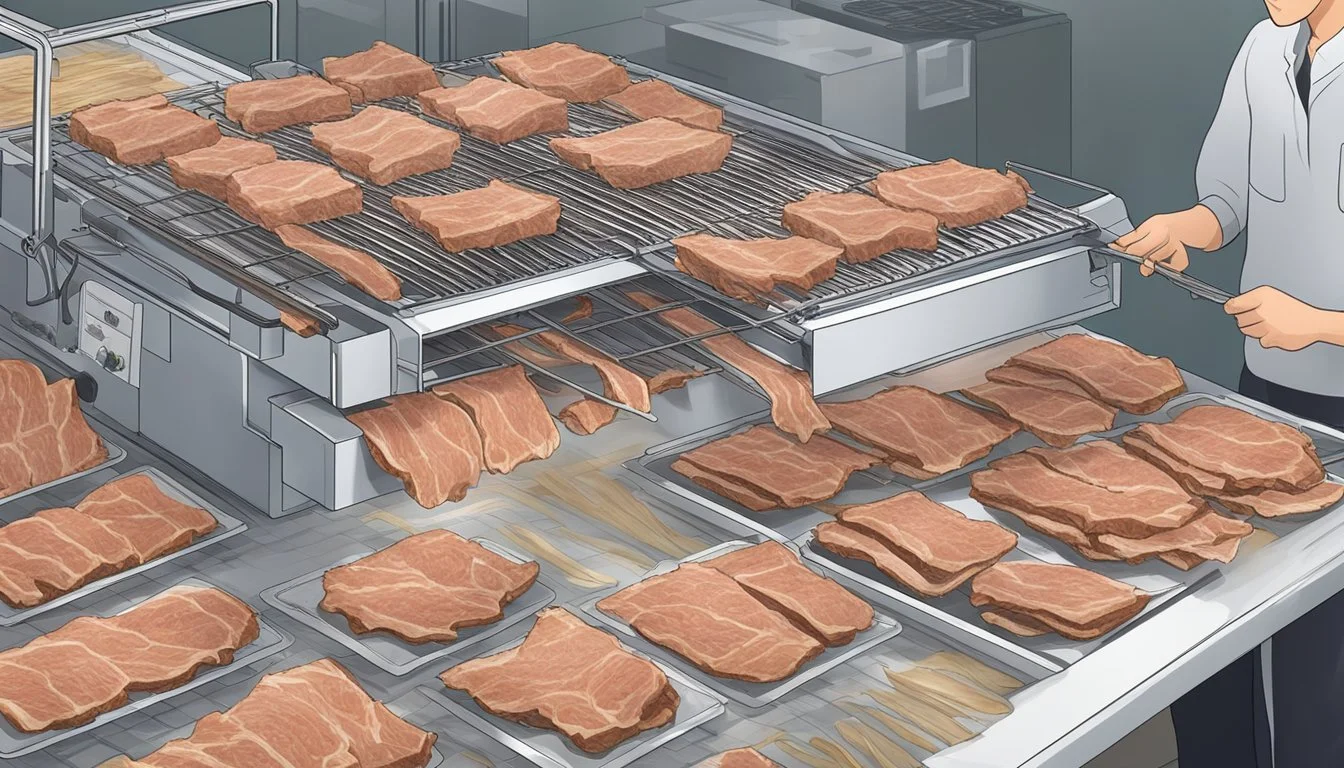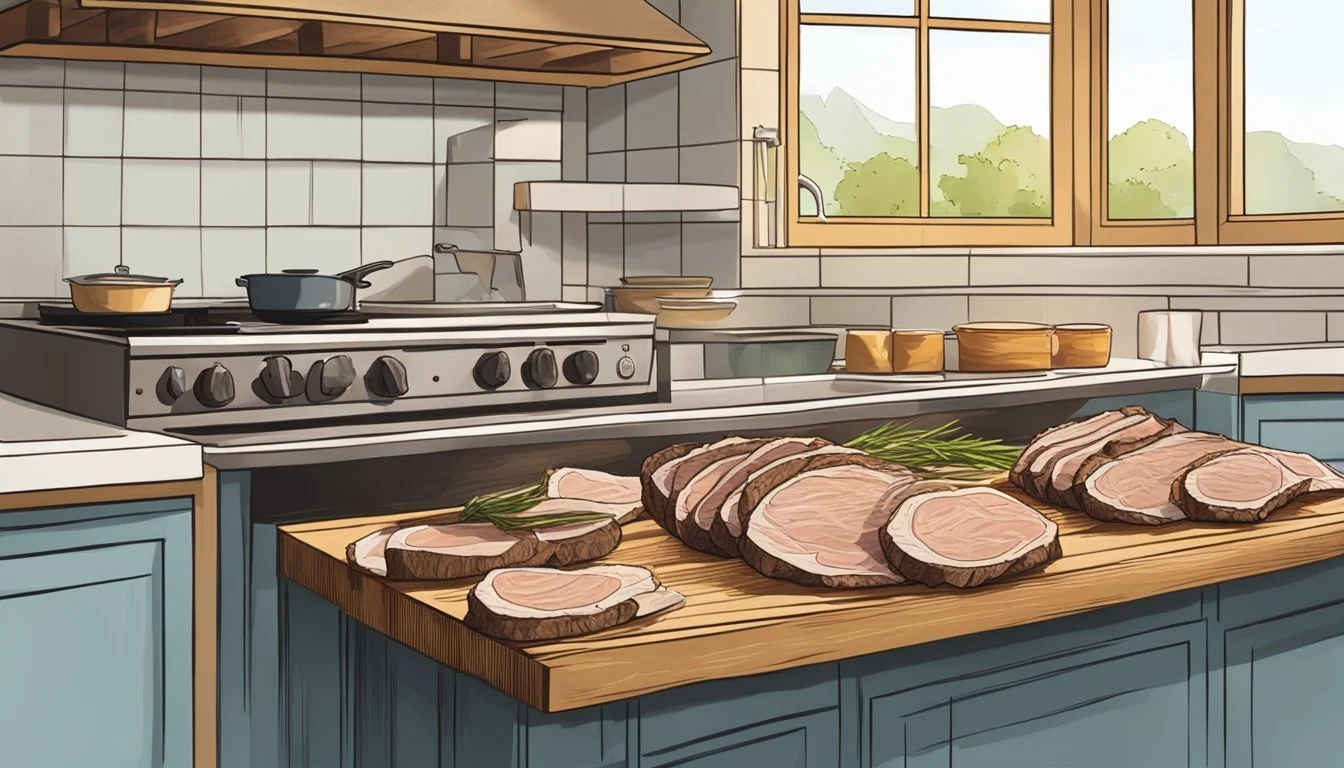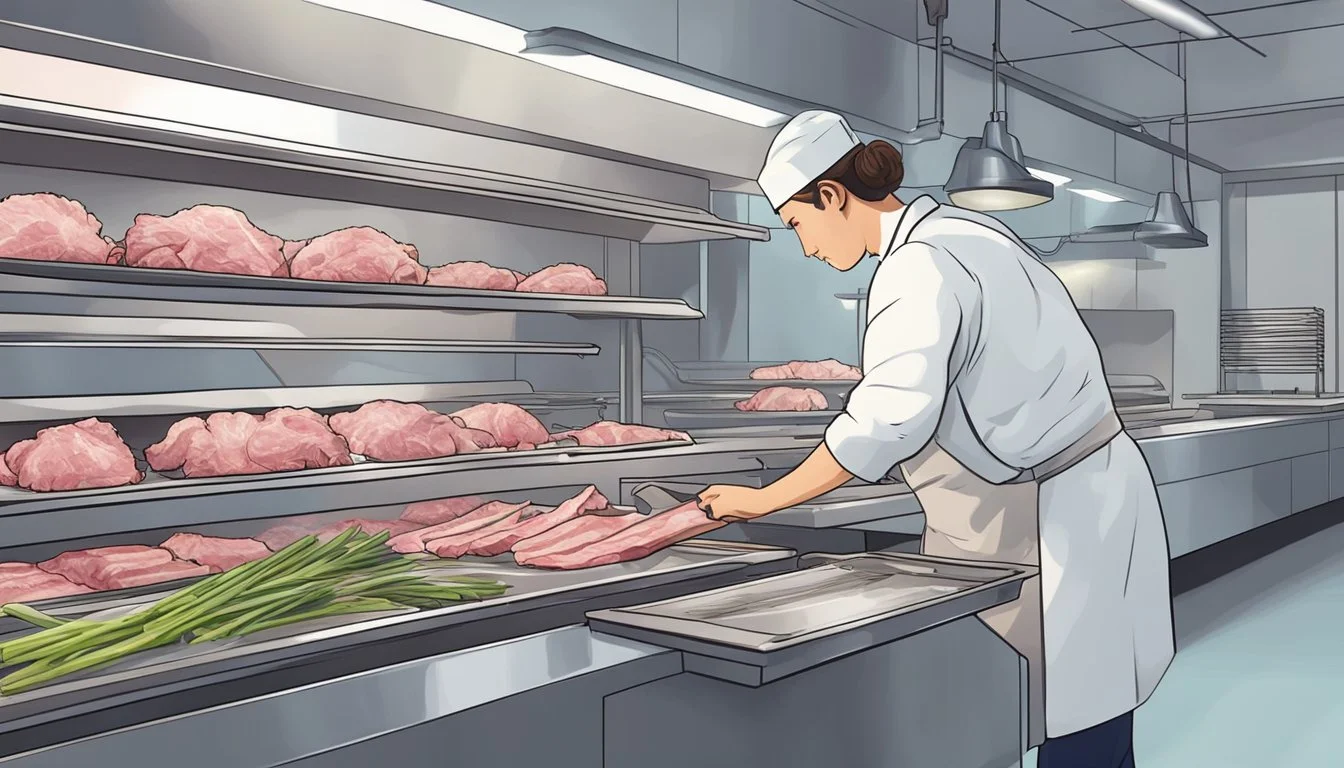Lamb Jerky Made Easy
Your Simple Guide to Homemade Treats
Lamb jerky is a savory snack that stands out due to its rich flavor and tender texture. Unlike traditional beef jerky, lamb jerky offers a unique taste that can be enhanced with a variety of seasonings and marinades. This delicacy is not only a great source of protein but also serves as a satisfying treat for both culinary beginners and connoisseurs alike. Creating lamb jerky at home is simpler than many might think and requires minimal equipment.
The process begins by choosing the right cut of lamb; a lean part like the leg is commonly used. Freezing the meat slightly before slicing helps in cutting consistent, thin strips which are essential for even drying. These strips are then typically marinated in a blend of choice seasonings—often incorporating herbs and spices that complement lamb's distinct flavor profile—before they are dried using either a dehydrator or an oven.
Making lamb jerky at home allows for a highly customizable experience, where creators can adjust levels of saltiness, sweetness, and spiciness to their preference. The curing period, which ranges from several hours to a day, is a crucial step that imbues the meat with bold flavors and prepares it for the drying phase. This low and slow process results in a chewy yet tender final product, ideal for a nutritious snack on the go.
Choosing Your Meat
When making lamb jerky, the quality of the final product is highly dependent on the meat selection process. It is crucial to pick the right cut and trim the excess fat to ensure both flavor and texture are optimal.
Selecting the Right Cut
For lamb jerky, the selection of the cut is a determining factor in the tenderness and ease of preparation of the final product. Ideal cuts are those with a consistent grain and minimal internal fat, such as the top round or eye of round. These cuts are lean and ideal for slicing into jerky pieces. While filet mignon is known for its tenderness, it is typically more expensive and not commonly used for jerky.
Trimming Excess Fat
Before marinating, one must trim away the excess fat from the lamb. Fat can cause the jerky to spoil more quickly, reducing its shelf life. After selecting the appropriate cut, they should use a sharp knife to carefully remove visible fat, creating a leaner piece of meat that will result in better jerky. The key is to leave as little fat as possible without compromising the integrity of the muscle fiber.
Preparing the Marinade
A good marinade is essential for flavorful lamb jerky, bringing a balance of savory, sweet, and aromatic notes. Here’s how one can prepare a marinade that will infuse the lamb with delicious flavors.
Mixing Ingredients
To create the marinade, start by combining liquid ingredients such as soy sauce and Worcestershire sauce in a suitable mixing bowl. These sauces serve as the base, offering depth and umami. Next, add sweetness with a tablespoon of honey or brown sugar, adjusting to taste. To enhance the complexity of the marinade, incorporate vinegar—apple cider or red wine vinegar work well. If a smoky flavor is desired, a few drops of liquid smoke or a substitution with teriyaki sauce can add an extra dimension. Finally, whisk in ground spices such as garlic powder, onion powder, and black pepper for a balanced seasoning profile.
Marinade Base:
Soy sauce: 1/2 cup
Worcestershire sauce: 1/4 cup
Sweetness (choose one):
Honey: 1 tablespoon
Brown sugar: 2 tablespoons
Acidity (choose one):
Apple cider vinegar: 2 tablespoons
Red wine vinegar: 2 tablespoons
Enhancers (optional):
Liquid smoke: 1 teaspoon
Teriyaki sauce: 1/4 cup (replace part of soy sauce)
Seasonings:
Garlic powder: 1 teaspoon
Onion powder: 1 teaspoon
Black pepper: 1/2 teaspoon
Marinating the Meat
Once the marinade is thoroughly mixed, it’s time to introduce the meat. Lay the thinly sliced lamb in a flat dish or a resealable bag and pour the marinade over, ensuring that all slices are well-coated. The key here is even coverage for consistent flavor. Seal the bag or cover the dish and refrigerate. The lamb should be left to marinate for at least 4 hours, though for an intensified flavor profile, up to 24 hours is preferable. The longer marination time allows the flavors to penetrate deeply into the meat. Remember to turn the meat occasionally, promoting equal exposure to the marinade.
Slicing the Meat
Accurate slicing of meat is crucial to the quality of your lamb jerky. It determines both the jerky's texture and chewiness, typically linked to how you cut in relation to the meat's natural grain.
Against the Grain for Texture
When slicing against the grain, chefs look at the direction of the muscle fibers and slice perpendicularly to them. This approach yields a tender texture, as it shortens the muscle fibers, making the jerky easier to bite into. Here's how to do it:
Thickness: Aim for slices about 1/4 inch thick. This thickness ensures that the jerky is not too tough or too crumbly once dried.
Freezing: Partially freeze the lamb for easier slicing.
Knife: Use a sharp knife for clean cuts.
With the Grain for Chew
Slicing with the grain means cutting parallel to the muscle fibers. Jerky cut this way will have a more pronounced chewiness, ideal for those who enjoy a hearty chew in their snack. Keep these points in mind:
Thickness: Maintain consistent thickness, ideally around 1/4 inch, just as with against-the-grain slices.
Consistency: Ensure slices are uniform for even drying.
Handling: Cut with confidence but with care to preserve the integrity of the fibers.
Seasoning and Adding Flavors
Proper seasoning is crucial for creating flavorful lamb jerky. One can opt for a dry rub to coat the meat with a blend of spices, or immerse it in a wet marinade to tenderize and infuse deeper flavors.
Dry Rubs
For creating a dry rub, salt and pepper are essential as foundational ingredients. A popular combination for a rich flavor profile includes garlic powder, smoked paprika, and red pepper flakes for a touch of heat. One should evenly coat the lamb slices with the seasoning blend, ensuring all pieces are well-covered.
Sample Dry Rub Recipe:
2 tsp salt
1 tsp black pepper
1 tsp garlic powder
1 tsp smoked paprika
1/2 tsp red pepper flakes
Ensure that the spices are thoroughly mixed before applying to the meat.
Wet Marinades
Wet marinades typically combine soy sauce or Worcestershire sauce with a variety of spices like garlic powder, onion powder, chili powder, and sometimes a pinch of coriander. This blend creates a savory and slightly tangy base that deeply penetrates the lamb slices.
Sample Wet Marinade Recipe:
1/4 cup soy sauce
2 Tbsp Worcestershire sauce
1/2 tsp garlic powder
1/2 tsp onion powder
1/2 tsp chili powder
1/4 tsp coriander
Combine all ingredients and soak the meat for several hours, preferably overnight in the refrigerator, to allow the flavors to meld and the meat to tenderize.
Drying Methods
When making lamb jerky, the drying method is crucial to achieve the perfect texture and preserve the meat. Ensuring the temperature and drying time are accurate is key regardless of the method chosen.
Using a Dehydrator
A dehydrator applies consistent heat and airflow to dry the lamb strips. To use a dehydrator:
Place the seasoned lamb on the dehydrator racks, ensuring the pieces do not overlap.
Set the dehydrator to a temperature between 145°F to 165°F.
The drying time can vary, typically ranging from 4 to 12 hours, but one should check the jerky after 4 hours and then periodically until it achieves the desired dryness.
Oven-Drying Technique
If a dehydrator is not available, an oven can be used effectively with the following steps:
Preheat the oven to the lowest setting, ideally around 170°F.
Line baking sheets with aluminum foil and place a wire rack over the sheet to allow air circulation.
Arrange lamb slices on the rack without touching.
Leave the oven door slightly ajar to let moisture escape and dry the meat for about 4 to 8 hours, checking intermittently.
Smoking for Flavor
For those who appreciate a smoky flavor, a smoker serves both for drying and imparting taste. To smoke lamb jerky:
Preheat the smoker to 165°F to 180°F.
Place the marinated lamb on the racks without overcrowding.
Monitor the temperature closely and smoke the jerky until it is dry but still pliable, which may take roughly 4 to 6 hours.
Storing Homemade Jerky
Proper storage of homemade jerky is crucial to maintain its freshness and prevent spoilage. This section lays out specific methods to ensure that your jerky remains tasty and safe for consumption over time.
Cooling and Storage
After making jerky, it must be allowed to cool to room temperature before storage. Storing jerky while it's still warm could lead to condensation inside the storage container, which can encourage mold growth. Once cooled, the jerky should be placed in an airtight container such as a Ziploc bag or a vacuum-sealed bag to protect it from air and moisture.
Cooling: Ensure jerky is at room temperature.
Containers: Use an airtight container or Ziploc bag.
Prolonging Shelf Life
For optimal longevity, store the airtight container in a cool, dry place to prevent heat and light from degrading the jerky. If one does not plan to consume the jerky within two weeks, storing it in the refrigerator is advised. For storage periods extending beyond a month, the freezer offers the best solution for preserving the jerky's quality. When refrigerating or freezing, make sure the container is sealed properly.
Refrigerate: Good for monthly storage.
Freezer: Best for long-term storage beyond a month.
Safe Jerky Making
Creating safe lamb jerky involves careful attention to avoiding spoilage and maintaining appropriate temperatures throughout the process. These measures are critical in preserving the quality and safety of the protein while inhibiting the growth of harmful bacteria and the activity of enzymes that can lead to spoilage.
Avoiding Spoilage
When making jerky, one must mitigate factors that contribute to spoilage. Two key aspects are:
Protein Quality: Always start with high-quality lamb, ensuring it's fresh and properly handled before beginning the jerky-making process.
Curing: A proper cure that contains salt is vital. Curing not only imparts flavor but more importantly, acts as a preservative by inhibiting the growth of spoilage-causing bacteria.
Temperature and Food Safety
Temperature control is crucial for food safety during jerky making:
Initial Preparation: Freeze lamb for an hour before slicing to ensure proper cut consistency and reduce microbial activity.
Drying Temperature: The dehydration process should be done at temperatures of at least 160°F (71°C) to effectively eliminate pathogens.
Storage: Store the finished jerky in a cool, dry place or refrigerate to maintain freshness and extend shelf life.
By adhering to these guidelines, one can produce lamb jerky that not only tastes great but is also safe to consume.
Jerky Variations
In the realm of homemade jerky, variety is key—both in the type of meat chosen and the flavors infused into the final product. Venturing beyond traditional beef jerky allows one to explore a range of textures and tastes.
Beef Alternatives
Turkey Jerky: For a leaner option, turkey serves as an excellent substitute for beef. It's essential to select a lean cut of turkey breast, ensuring the jerky is not only healthy but also delectable.
Ground Beef Jerky: Another variation to consider is jerky made from ground beef. This option allows for a more tender bite and can be easier to work with for beginners. When creating ground beef jerky, it's imperative to press the meat flat to achieve an even thickness, which promotes consistent drying.
Experimenting with Flavors
Homemade jerky enthusiasts have the freedom to tailor flavors to their liking. A basic jerky marinade often includes soy sauce and Worcestershire sauce, but adding different ingredients can transform the taste profile:
Sweet: Incorporate honey or brown sugar
Spicy: Add diced jalapenos or chili flakes
Savory: Use garlic powder, onion powder, or smoked paprika
Herbaceous: Fresh herbs like rosemary or thyme can infuse the meat with aromatic flavor
To fully coat the meat, it's recommended to marinate for at least 4-12 hours, depending on the recipe. This marinade time ensures that the flavors permeate the meat, resulting in a richer, more complex flavor in the finished jerky.
Frequently Asked Questions
In this section, readers will find answers to common inquiries about the equipment needed for jerky making and the health-related aspects to consider.
Jerky Making Equipment
What equipment is essential for making lamb jerky?
Dehydrators: Essential for drying meat consistently; they regulate temperature and airflow.
Wire Racks or Meat Hooks: Handy for hanging meat if one prefers to air-dry or smoke the jerky.
Slicing Tools: A sharp knife or meat slicer ensures even, thin slices that dry uniformly.
Marinade Containers: Bowls or sealable bags for thoroughly coating meat slices in seasoning.
Health and Nutritional Concerns
Is lamb jerky nutritious? Lamb jerky can be a good source of protein with the nutritional profile often reflecting the marinade and cooking process used. Here's a general nutritional guideline per 1-ounce serving:
Calories: Approximately 60-90, depending mainly on marinade ingredients and fat content.
Protein: Ranges from 9 to 12 grams, contributing to muscle maintenance and growth.
Fat: Varied amounts, with leaner cuts having less fat.
It's important to underscore that homemade jerky allows for control of added ingredients, which can be adjusted to meet specific dietary preferences or restrictions.
Conclusion
Making lamb jerky at home is a rewarding process that allows for creativity in flavor and personalization in texture. It requires attention to detail during the preparation phase and patience during the drying process. Once the basics are mastered, home chefs can experiment with a wide array of seasoning combinations to suit their taste.
Key Takeaways:
Preparation: Freeze the lamb briefly to aid in slicing, and ensure slices are consistent in thickness for even drying.
Marination: A thorough marination not only infuses flavors but also tenderizes the meat. Allow ample time for this step.
Drying: Whether using an oven, a dehydrator, or a smoker, it's imperative that the meat dries uniformly, without any moisture, to prevent spoilage.
By following simple guidelines, food enthusiasts can produce high-quality lamb jerky in their own kitchen. The final product is not only tasty but also a high-protein snack that can be enjoyed on many occasions. With practice, anyone can refine their technique and craft delicious homemade jerky.









